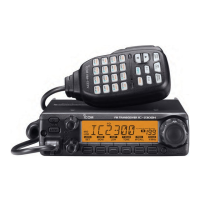Previous view
8
BASIC OPERATION
3
■ Receiving
q Hold down [ ] for 1 second to turn ON the power.
w Rotate [VOL] to adjust the audio level.
➥ Push [MONI] to open the squelch, and then rotate
[VOL] to adjust the audio level.
e Set the squelch level.
➥ First, rotate [SQL] fully counterclockwise, and
then rotate [SQL] clockwise until the noise just
disappears.
r Set the operating frequency. (p. 5)
t When you receive a signal, the squelch opens and
audio can be heard.
• The “BUSY” icon appears, and the S/RF indicator
shows the relative strength of the received signal.
Using the HM-133V
The audio level can also be adjusted by pushing
[VOLY] or [VOLZ] .
The squelch level can also be adjusted by pushing
[SQLY] or [SQLZ] .
■ Monitor function
This function is used to listen to weak signals without
disturbing the squelch setting, or to manually open the
squelch, even when the tone squelch is in use.
➥ Push [MONI] to open the squelch.
• The “BUSY” icon blinks.
• Push [MONI] again to cancel the function.
Using the HM-133V
➥ Push [MONI] to open the squelch.
• Push [MONI] again to cancel the function.
NOTE: When the squelch adjustment is set to too far
clockwise (12 –17 o’clock position), the S-meter
squelch or squelch attenuator is activated. To moni-
tor weak signals, deactivate the S-meter squelch or
squelch attenuator function. See page 9 for details.
LOCK
S
E
T
ANM
MONI
DUP
LOW
T
-
SCAN
TONE
PRIO
M/CALL
SCAN
V/MHz
DIGITAL
PRIO
AO
BUSY
MUTE
NAR
MID
LOW
Push [MONI] to open the squelch.
LOCK
S
E
T
ANM
MONI
DUP
LOW
T
-
SCAN
TONE
PRIO
M/CALL
SCAN
V/MHz
DIGITAL
PRIO
AO
BUSY
MUTE
NAR
MID
LOW
Push to open the squelch.
LOCK
S
E
T
ANM
MONI
DUP
LOW
T
-
SCAN
TONE
PRIO
M/CALL
SCAN
V/MHz
DIGITAL
PRIO
AO
BUSY
MUTE
NAR
MID
LOW
Audio level
Push / to adjust the audio level.
LOCK
S
E
T
ANM
MONI
DUP
LOW
T
-
SCAN
TONE
PRIO
M/CALL
SCAN
V/MHz
DIGITAL
PRIO
AO
BUSY
MUTE
NAR
MID
LOW
Squelch level
Push / to adjust the squelch level.
LOCK
S
E
T
ANM
MONI
DUP
LOW
T
-
SCAN
TONE
PRIO
M/CALL
SCAN
V/MHz
DIGITAL
PRIO
AO
BUSY
MUTE
NAR
MID
LOW
Appears when receiving a signal.

